SDR-Software Defined Radio Course Syllabus
Introduction and Basic Concepts
- Introduction
- RF and Microwaves Frequency Spectrum
- Time and Frequency Domains, Fourier series and Transform
- Linear systems, Modulation (Heterodyning) and Frequency-Shifting
- I-Q and Phasor diagrams
- Power – instantaneous, mean and peak
- The Decibel units, dBm, dBW, dBµV/m
- Coherent and Incoherent signals
- Thermal Noise model
- Friis Communication free-space link budget
- Noise factor, noise figure and sensitivity of receiving systems
- Non-linearity, characterization and calculations of Spurii levels and Dynamic range
- Radio architectures – from classical up to Software-defined-radio (SDR)
- SDR components, HW and SW (physical layer, PHY)
- Proficiencies we’ll focus on during this Course

Sampling, Communications and Elements of the SDR
- Classical and sub – sampling, properties of time-discrete signals and systems
- Frequency-domain characteristics of time-sampled signals, resolution and leakage
- Spectrum (DFT, FFT), time-windows and their effect on the spectrum
- Spectral power density of time-sampled noise
- ADC and DAC conversions, quantization noise, parameters and current performance (TI, ADI, LIME)
- Matching an RF front-end to an ADC, w/o and with AGC
- Band-limited Noise, amplitude and phase noise
- Correlation, extension of the mean-power, application to time-delay estimation
- The SDR front-end block-diagram and performance
- Review of Analog Communications (AM, SC-DSB, FM, SSB)
- Review of Digital Communications, bits/symbols, constellation, eye-pattern,..
- ..error-probability (BER, FER), digital modulations (ASK, FSK, M-PSK, QAM)
- Multiple-Access in time, frequency, coding (CDMA), time-frequency (OFDMA) and space (SDMA)
- Modulation formats that we’ll generate and receive along this Course

Simulation of Signals and Time/Frequency Analysis; Matlab-Simulink
- Matlab – basics, including demonstration and exercising
- Mathematical operations, scalar and vector variables
- Errors and referring to the SW comments
- Functions of one variable, graphical representations
- Simulink – basics, including demonstration and exercising
- Signal sources, usable libraries, AWGN source
- Program (Block-diagram) run, stop – changing parameters during an active run
- Measurement and display blocks in time and frequency domains (Spectrum Analyzer, Scope)
- Self-generating measurement blocks, and using Library-ready blocks
- Division, combining (summing) and multiplexing (MUX) junctions
- Generation and display of single-tone, two-tones, w/o and with noise
- Fixed- and floating-point representations, quantization noise
- NSD and SNR measurements
- Importing data from file, or an external peripheral (e.g. microphone)
- Exporting data to a file, or to an external peripheral (e.g. speaker)

- Matlab – basics, including demonstration and exercising
Signals Simulation and Analysis in Time/Frequency domains: BB Pulses, AM
- Signals at baseband (BB) and at IF/RF
- Matched filter – problem statement, objective and optimization criterion, the result
- Mismatch losses in detection
- Applications of pulse transmissions: PPM communications, Radar; estimating time-of-Arrival (TOA)
- SIMULINK – Simulating transmission and reception of pulses (a pulse train), including demonstration and exercising
- Square pulses, RRC shaped pulses with parameter α, AWGN, MF
- Creating the Model, setting the SNR (a parameter) and running
- Estimation the epoch of peak reception (at MF output; used for initial time-synchronization)
- Displaying the TOA epochs as function of the frames’ index
- Repeat for several SNR values, threshold effect
- Mismatch effects, measurement of mismatch losses
- Amplitude Modulation – Definition, block-diagram
- Characteristics of AM in time, frequency, phasor diagram, and powers: mean and peak
- Single-tone AM – predict the transmission characteristics
- SIMULINK – simulate transmission and reception of AM, including demonstration and exercising
- The Transmitter – block diagram, options for a synthesized information source, or recorded or live (from a microphone)
- The channel – AWGN
- The Receiver – Frequency range, bandwidth
- Output to a Speaker, and time and frequency displays
- Reception of a live AM transmission
Signals Simulation and Analysis in Time/Frequency domains: DSB - SC, FM
- DSB-SC modulation – Definition, block-diagram
- DSB properties in time, frequency, phasor diagram, and powers: mean and peak
- Single-tone DSB – predict the transmission characteristics
- SIMULINK – Simulating transmission and reception of a DSB signal, including demonstration and exercising
- The Transmitter – block diagram, options for a synthesized information source, or recorded or live (from a microphone)
- The channel – AWGN
- The Receiver – Frequency range, bandwidth
- Output to a Speaker, and time and frequency displays
- Frequency Modulation – Definition, block-diagram
- Characteristics of FM in time, frequency, and powers: mean and peak
- Single-tone FM – predict the transmission characteristics
- SIMULINK – simulate transmission and reception of FM, including demonstration and exercising
- The Transmitter – block diagram, options for a synthesized information source, or recorded or live (from a microphone)
- The channel – AWGN
- The Receiver – Frequency range, bandwidth
- Output to a Speaker, and time and frequency displays
- Reception of a live FM transmission

Signals Simulation and Analysis in Time/Frequency domains: SSB, OOK
- SSB modulation – Definition, block-diagram transmitter and Receiver
- SSB properties in frequency, and powers: mean and peak
- Single-tone SSB – predict the transmission characteristics
- Practical effects: LO leakage, Image rejection
- SIMULINK – Simulating transmission and reception of an SSB signal, including demonstration and exercising
- The Transmitter – block diagram, options for a synthesized information source, or recorded or live (from a microphone)
- The channel – AWGN
- The Receiver – Frequency range, bandwidth
- Output to a Speaker, and time and frequency displays
- Reception of a live SSB transmission?
- On-Off Keying Modulation – Definition, block-diagram
- Characteristics of OOK in time, frequency, and powers: mean and peak
- OOK with a random data sequence – predict the transmission characteristics
- SIMULINK – simulate transmission and reception of an OOK signal, including demonstration and exercising
- The Transmitter – block diagram, options for a synthesized information source, or recorded
- The channel – AWGN
- The Receiver – Frequency range, bandwidth, Matched Filter
- Output to time display, EVM
Signals Simulation and Analysis in Time/Frequency domains: FSK, M-PSK
- FSK modulation – Definition, block-diagram of Tx and Rx
- Optimization of the modulation index for best reception
- FSK properties in time, frequency, and powers: mean and peak
- FSK with a random data sequence – predict the transmission characteristics
- SIMULINK – Simulating transmission and reception of an FSK signal, including demonstration and exercising
- The Transmitter – block diagram, options for a synthesized information source, or recorded
- The channel – AWGN
- The Receiver – Frequency range, bandwidth, Matched Filter
- Output to time and frequency displays
- Sensitivity to frequency offsets (due to HW or Doppler)
- M-PSK modulation – Review characteristics, coding and demodulation approaches
- M-PSK properties in time, frequency, constellation (w/o and with Trajectories) and powers: mean and peak
- M-PSK modulation – Definition, block-diagram of Tx and Rx (Differential and coherent)
- M-PSK with a random data sequence – predict the transmission characteristics (mean-power Spectrum)
- SIMULINK – Simulating transmission and reception of an M-PSK signal, including demonstration and exercising
- The Transmitter – block diagram, options for a synthesized information source, or recorded
- The channel – AWGN
- The Receiver – Frequency range, bandwidth, Matched Filter
- Output to time and constellation displays, EVM
- Sensitivity to AM/AM and AM/PM deviations (due to non-linearity)

Signals Simulation and Analysis in Time/Frequency domains: QAM
- QAM modulation – Review characteristics, coding and demodulation approaches
- QAM properties in time, frequency, constellation (w/o and with Trajectories) and powers: mean and peak
- QAM modulation – Definition, block-diagram of Tx and Rx
- QAM with a random data sequence – predict the transmission characteristics (mean-power Spectrum)
- SIMULINK – Simulating transmission and reception of an QAM signal, including demonstration and exercising
- The Transmitter – block diagram, options for a synthesized information source, or recorded
- The channel – AWGN
- The Receiver – Frequency range, bandwidth, Matched Filter
- Output to time and constellation displays, EVM
- Sensitivity to AM/AM and AM/PM deviations (due to non-linearity)

System Simulation and Analysis in Time/Frequency domains: AGC, PLL, Costas-Loop
- Review the theory of AGC
- Modeling approaches for the AGC loop
- SIMULINK – Simulating the AGC loop, including demonstration and exercising
- The Transmitter – block diagram, a source with low-rate power level changes
- The channel – AWGN
- The Receiver – Frequency range, bandwidth, AGC
- Output to time display and demonstrating the response time-constant
- Tx level-change rate that deceives the analog AGC loop
- Review the theory of PLL
- Modeling the PLL loop
- Applications for CW (or Clock) reconstruction, and for FM/FSK demodulation
- Costas loop – for pilot-less signal cases, refer also to the Squaring loop
- SIMULINK – Simulating the PLL, altogether with a Costas loop, including demonstration and exercising
- The Transmitter – block diagram, a source with low-rate frequency changes
- The channel – AWGN
- The Receiver – Frequency range, bandwidth, PLL
- Output to time display and demonstrating the response time-constant
- Demonstrate the instantaneous lock range
- Phase tracking error (RMS)
- FM transmitter and changing the loop BW parameter of the PLL
- Demonstrate FM reception with a PLL
- Demonstrate live FM reception

System Simulation and Analysis in Time/Frequency domains: CFL Linearization
- Review the challenge (problem) – realization of transmitters producing undistorted signal spectrum
- Linearization methods – a brief review
- Feedback loop constraints – control theory considerations
- CFL setup – manual or automatic, explain the process
- SIMULINK – Simulating the transmission w/o and with CFL, including demonstration and exercising
- The Source – a 2-tone or CDMA signal
- The model construction, parameters’ setting, and run
- The effect of an improper loop setup on (in)stability
- Display Spectrum w/o and with feedback correction
- Demonstrate the transmission with a R&S signal generator and RF amplifier?




